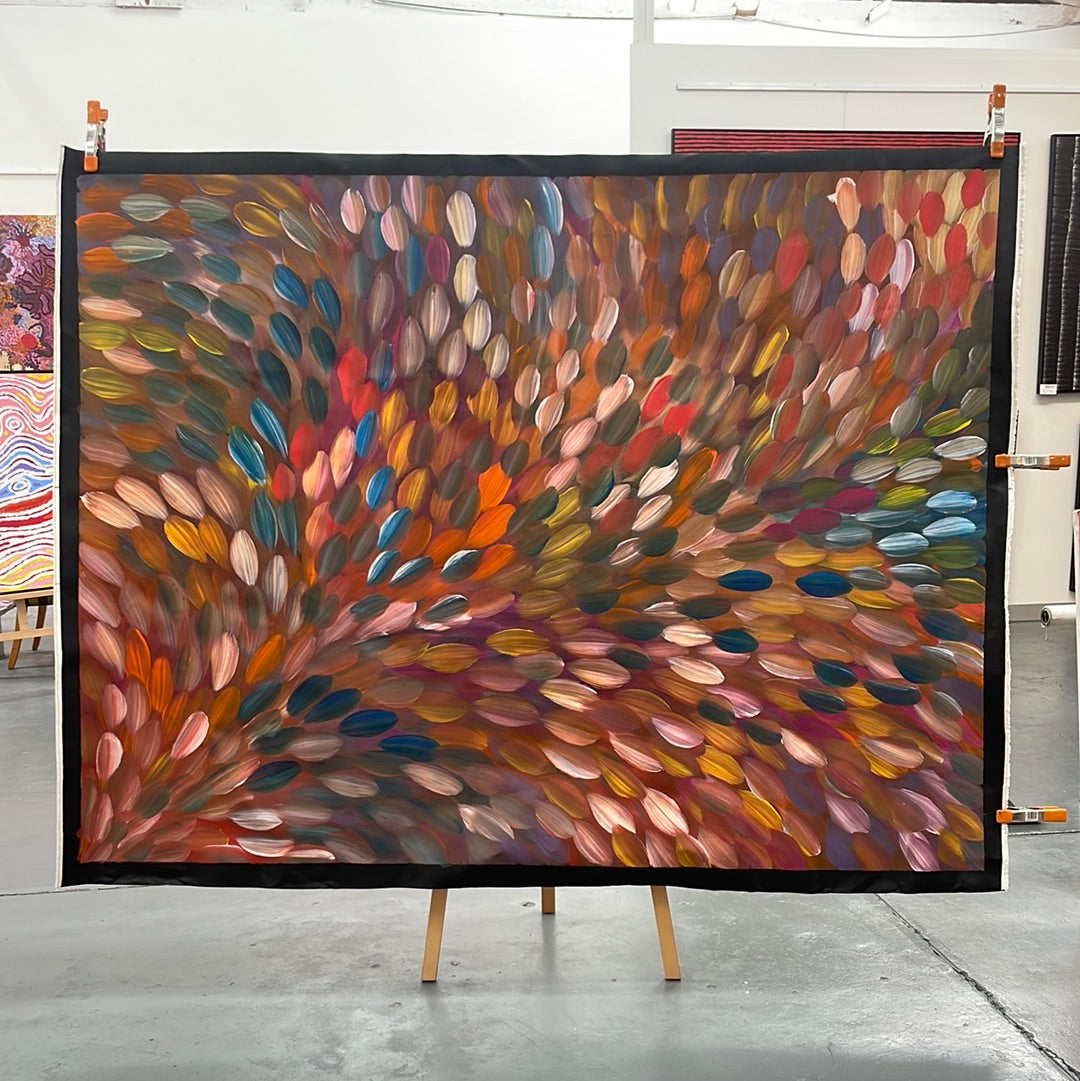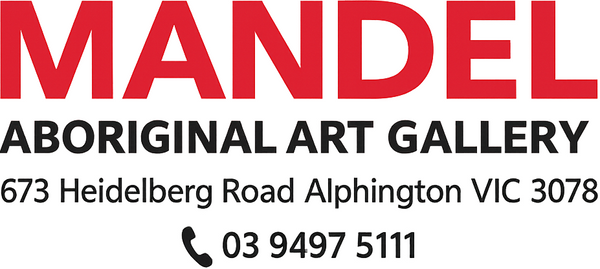
11 Facts About Aboriginal Art
Share
Exploring the Rich Tapestry of Aboriginal Art Facts: 11 Facts About Aboriginal Art
What is Aboriginal Art?
Aboriginal art is a cornerstone of Australia's cultural heritage, embodying millennia of tradition, spirituality, and connection to the land. Aboriginal art stands as a vibrant testament to the cultural richness and artistic heritage of Australia's indigenous peoples. It embodies stories of ancient traditions, spiritual beliefs, and the profound connection to the land. Let's delve into the intricate world of Aboriginal art and uncover some fascinating facts.
1. How Old is Aboriginal Art?
The origins of Aboriginal art can be traced back over 30,000 years, making it one of the oldest continuous art traditions in the world. This art form served as a means of storytelling, communication, and cultural expression within Aboriginal communities.
The oldest known Aboriginal artworks are rock paintings found in caves and shelters across Australia, depicting scenes from daily life, spiritual beliefs, and Dreamtime stories. These artworks served as both a form of communication and a way of preserving cultural knowledge for future generations.
Central to Aboriginal art is the concept of Dreamtime or the Dreaming, a spiritual belief system that encompasses the creation of the world by ancestral beings. Dreamtime stories are passed down orally from generation to generation and are often depicted in Aboriginal artworks. These stories hold deep significance for Indigenous Australians, connecting them to their ancestors, the land, and the spiritual realm.
2. What Are the Diverse Styles and Techniques Used in Aboriginal Art?
Aboriginal art encompasses a wide range of styles and techniques, each with its own unique characteristics and cultural significance.
Dot Painting
One of the most recognizable forms of Aboriginal art is dot painting, where intricate patterns of dots are meticulously applied to create vibrant, textured compositions. Each dot carries symbolic meaning, representing elements of the natural world, ancestral spirits, or Dreamtime stories.
Dot painting originated from ceremonial body painting and sand drawing traditions, evolving into a distinctive art form celebrated for its visual complexity and storytelling capabilities.
Bark Painting
Bark painting is another traditional technique used by Aboriginal artists, where artworks are created on tree bark using natural pigments. These paintings often depict scenes from Dreamtime stories or serve as maps of the land, reflecting the close relationship between Aboriginal people and their environment. Bark painting is a revered practice among Indigenous communities, preserving cultural knowledge and ancestral connections through visual storytelling.t.
Bush Medicine Leaves Painting
In addition to dot painting and bark painting, another notable technique in Aboriginal art is bush medicine leaves painting. This style involves using crushed leaves and natural pigments to create intricate designs on various surfaces.
Traditionally, these paintings served both aesthetic and practical purposes, as certain medicinal plants depicted held healing properties according to Indigenous knowledge systems.
Bush medicine leaves painting reflects the deep connection between Aboriginal people and the natural world, highlighting the holistic approach to health and wellbeing within Indigenous cultures.
3. How Does Aboriginal Art Preserve Cultural Traditions?
Aboriginal art plays a vital role in preserving cultural traditions and passing down knowledge from one generation to the next. Through art-making practices, Indigenous elders impart wisdom and teachings to younger members of the community, ensuring the continuity of cultural heritage.
Art serves as a tangible link to the past, connecting Indigenous peoples to their ancestors and keeping traditions alive in a rapidly changing world.
In recent decades, there has been a resurgence of interest in Aboriginal art both domestically and internationally. Recognized for its cultural significance and artistic merit, Aboriginal art has gained prominence in galleries, museums, and private collections worldwide.
This newfound recognition has provided Indigenous artists with platforms to share their stories, challenge stereotypes, and reclaim their cultural identity on a global scale.
4. What Is the Connection Between Aboriginal Art and the Land?
Many Aboriginal artworks are inspired by the Australian landscape, portraying the natural beauty and sacred sites of the country. These representations serve as a form of connection to Country, reinforcing the spiritual bond between Indigenous Australians and their ancestral lands.
Through art, Indigenous artists express their deep reverence for the land, celebrating its beauty and acknowledging its importance in sustaining cultural traditions
Through their art, Aboriginal artists convey important messages about environmental conservation and the need to protect the land for future generations. Their deep reverence for the natural world shines through in intricate depictions of flora, fauna, and ecological balance.
Aboriginal art serves as a powerful reminder of humanity's interconnectedness with the environment, urging us to adopt sustainable practices and preserve the planet for future generations.
5. How Does Symbolism and Storytelling Shape Aboriginal Art?
Aboriginal art is rich in symbolism, with each element carrying layers of meaning and significance. From the patterns of dots to the choice of colors, every aspect of the artwork tells a story, conveying messages about identity, spirituality, and cultural belonging.
Through art, Indigenous artists communicate complex narratives that bridge the gap between past and present, inviting viewers to explore the depths of Indigenous culture and history.
Traditionally, Aboriginal art was inseparable from oral storytelling, with artworks serving as visual representations of narrative traditions. Through art and storytelling, Indigenous Australians share their history, customs, and spiritual beliefs with younger generations.
This oral tradition continues to thrive today, as Indigenous artists draw upon ancestral knowledge and cultural practices to create artworks that resonate with contemporary audiences while honoring the wisdom of their ancestors.
6. How Does Aboriginal Art Showcase Cultural Diversity?
Aboriginal art encompasses a diverse range of styles and techniques, reflecting the unique cultural practices and artistic traditions of different Indigenous communities across Australia.
From the vibrant dot paintings of the Western Desert to the intricate cross-hatching of Arnhem Land, each region boasts its own distinctive artistic heritage. These regional variations not only showcase the creativity and ingenuity of Indigenous artists but also highlight the cultural diversity within Aboriginal communities.
While rooted in tradition, Aboriginal art continues to evolve and adapt to contemporary contexts. Many Indigenous artists blend traditional techniques with modern materials and themes, creating innovative artworks that speak to the complexities of contemporary Indigenous identity.
From urban street art to digital media, Aboriginal artists are exploring new forms of expression while maintaining a strong connection to their cultural roots. This fusion of tradition and innovation reflects the resilience and adaptability of Indigenous cultures in the face of ongoing social and cultural change.
7. What Economic Opportunities Does Aboriginal Art Provide?
Art as Livelihood
For many Aboriginal artists, creating and selling artworks is not only a form of cultural expression but also a means of economic empowerment. The art market provides opportunities for Indigenous artists to generate income, support their families, and contribute to the economic development of their communities.
By investing in Aboriginal art, collectors and patrons can directly support Indigenous livelihoods while preserving cultural heritage for future generations.
Fair Trade Practices
Efforts have been made to ensure that Aboriginal artists receive fair compensation for their work and are protected from exploitation. Initiatives such as the Indigenous Art Code promote ethical standards and transparency in the Aboriginal art industry, fostering greater respect for Indigenous cultural rights.
By supporting fair trade practices and ethical sourcing, consumers can contribute to the sustainability of Aboriginal art industries and uphold the rights of Indigenous artists
8. How Can Education and Awareness Support Aboriginal Art?
Aboriginal art serves as a powerful tool for education and cross-cultural understanding, offering insights into Indigenous perspectives, history, and contemporary issues. Through exhibitions, workshops, and educational programs, audiences gain a deeper appreciation for Aboriginal culture and the importance of cultural diversity.
By engaging with Aboriginal art, viewers can challenge stereotypes, confront biases, and foster greater empathy and understanding across cultural divides.
Many schools incorporate Aboriginal art into their curriculum as a way of teaching students about Indigenous history, culture, and artistic traditions. By exposing students to diverse cultural perspectives through art, educators can promote critical thinking, creativity, and cultural awareness.
Aboriginal art provides a valuable opportunity for students to explore Indigenous cultures, challenge stereotypes, and develop a deeper understanding of Australia's rich cultural heritage.
9. Global Influence
Aboriginal art has captivated audiences around the world, earning recognition for its unique aesthetic appeal and cultural significance. From major art institutions to grassroots galleries, Aboriginal artists have showcased their talents on the global stage, contributing to the diversity of the contemporary art world.
Through exhibitions, cultural exchanges, and collaborations, Aboriginal artists have forged connections with artists and audiences from diverse cultural backgrounds. These exchanges enrich artistic practices, foster mutual understanding, and promote dialogue about shared human experiences.
10. What Challenges and Opportunities Exist in the Aboriginal Art Industry?
Cultural Appropriation
Despite its popularity, Aboriginal art faces challenges such as cultural appropriation, where non-Indigenous artists and businesses exploit Indigenous cultural symbols and motifs for commercial gain. Initiatives to protect Indigenous cultural heritage and promote ethical practices are essential for addressing these issues.
Empowerment Through Art
Despite these challenges, Aboriginal art continues to thrive as a powerful form of cultural expression and resilience. By supporting Indigenous artists and respecting their cultural rights, we can contribute to the preservation and celebration of Aboriginal art for future generations.
Economic Sustainability
While Aboriginal art provides economic opportunities for many Indigenous artists, there are concerns about the sustainability of the art market and its impact on traditional practices. Balancing economic viability with cultural integrity is crucial to ensuring that Aboriginal artists can continue to practice their craft in a way that respects their cultural heritage and values.
Access to Resources
Access to resources such as art supplies, studio space, and marketing opportunities can pose challenges for Aboriginal artists, particularly those living in remote communities. Efforts to improve access to resources and support infrastructure development in Indigenous communities are essential for fostering the growth and sustainability of Aboriginal art industries.
11. Celebrating Diversity and Resilience
At its core, Aboriginal art is a celebration of resilience, creativity, and cultural survival. Despite centuries of adversity, Indigenous Australians have maintained their cultural traditions and artistic practices, demonstrating the enduring strength and vitality of Aboriginal culture.
As we celebrate the rich tapestry of Aboriginal art, let us also acknowledge the diversity of Indigenous cultures and the contributions of Aboriginal artists to the global artistic landscape. By embracing diversity and fostering mutual respect, we can honor the legacy of Aboriginal art and support Indigenous communities in their ongoing cultural journey.
Take Action: Support Aboriginal Art with Mandel Art Gallery
Now that you've learned about the rich cultural heritage and artistic traditions of Aboriginal art, consider how you can support Indigenous artists and communities.
By taking action to support Aboriginal art, you contribute to the preservation, celebration, and empowerment of Indigenous cultures and communities.
Join us at Mandel Aboriginal Art Gallery. Contact us or call us at (03) 9497 5111. Together, we can honor the legacy of Aboriginal art and ensure that it continues to thrive for generations to come.

